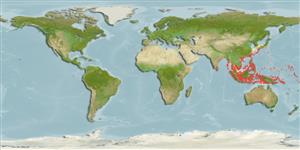Teleostei (teleosts) >
Eupercaria/misc (Various families in series Eupercaria) >
Lethrinidae (Emperors or scavengers) > Monotaxinae
Etymology: Gymnocranius: Greek, gymnos = naked + Greek, kranion = skull (Ref. 45335).
More on author: Bleeker.
Environment: milieu / climate zone / depth range / distribution range
Ecology
Marine; reef-associated; non-migratory; depth range 15 - 50 m (Ref. 2295). Tropical; 37°N - 10°S
Indo-West Pacific: known only from southern Japan, the South China Sea, the Marshall Islands, and off Phuket, Thailand in the Andaman Sea.
Size / Weight / Age
Maturity: Lm ? range ? - ? cm
Max length : 45.0 cm TL male/unsexed; (Ref. 2295); common length : 35.0 cm TL male/unsexed; (Ref. 2295)
Found over sandy and rubble bottoms near rock and coral reefs. Solitary on sand slopes in clear coastal lagoon habitats (Ref. 48635). May be found in small groups (Ref. 90102). Feeds on small bottom-living invertebrates. Marketed fresh (Ref. 9775).
Life cycle and mating behavior
Maturities | Reproduction | Spawnings | Egg(s) | Fecundities | Larvae
Carpenter, K.E. and G.R. Allen, 1989. FAO Species Catalogue. Vol. 9. Emperor fishes and large-eye breams of the world (family Lethrinidae). An annotated and illustrated catalogue of lethrinid species known to date. FAO Fish. Synop. 125(9):118 p. Rome: FAO. (Ref. 2295)
IUCN Red List Status (Ref. 130435)
Threat to humans
Harmless
Human uses
Fisheries: minor commercial
Tools
Special reports
Download XML
Internet sources
Estimates based on models
Preferred temperature (Ref.
123201): 24.4 - 29.1, mean 28.3 °C (based on 596 cells).
Phylogenetic diversity index (Ref.
82804): PD
50 = 0.5010 [Uniqueness, from 0.5 = low to 2.0 = high].
Bayesian length-weight: a=0.01778 (0.00761 - 0.04154), b=2.97 (2.78 - 3.16), in cm total length, based on LWR estimates for this (Sub)family-body shape (Ref.
93245).
Trophic level (Ref.
69278): 3.4 ±0.41 se; based on food items.
Resilience (Ref.
120179): Medium, minimum population doubling time 1.4 - 4.4 years (Preliminary K or Fecundity.).
Fishing Vulnerability (Ref.
59153): Low to moderate vulnerability (35 of 100).
Nutrients (Ref.
124155): Calcium = 37.1 [18.9, 64.9] mg/100g; Iron = 0.512 [0.282, 0.828] mg/100g; Protein = 19.5 [17.5, 21.5] %; Omega3 = 0.123 [0.073, 0.174] g/100g; Selenium = 33.8 [21.2, 57.9] μg/100g; VitaminA = 65.8 [20.4, 185.7] μg/100g; Zinc = 1.16 [0.84, 1.56] mg/100g (wet weight);
